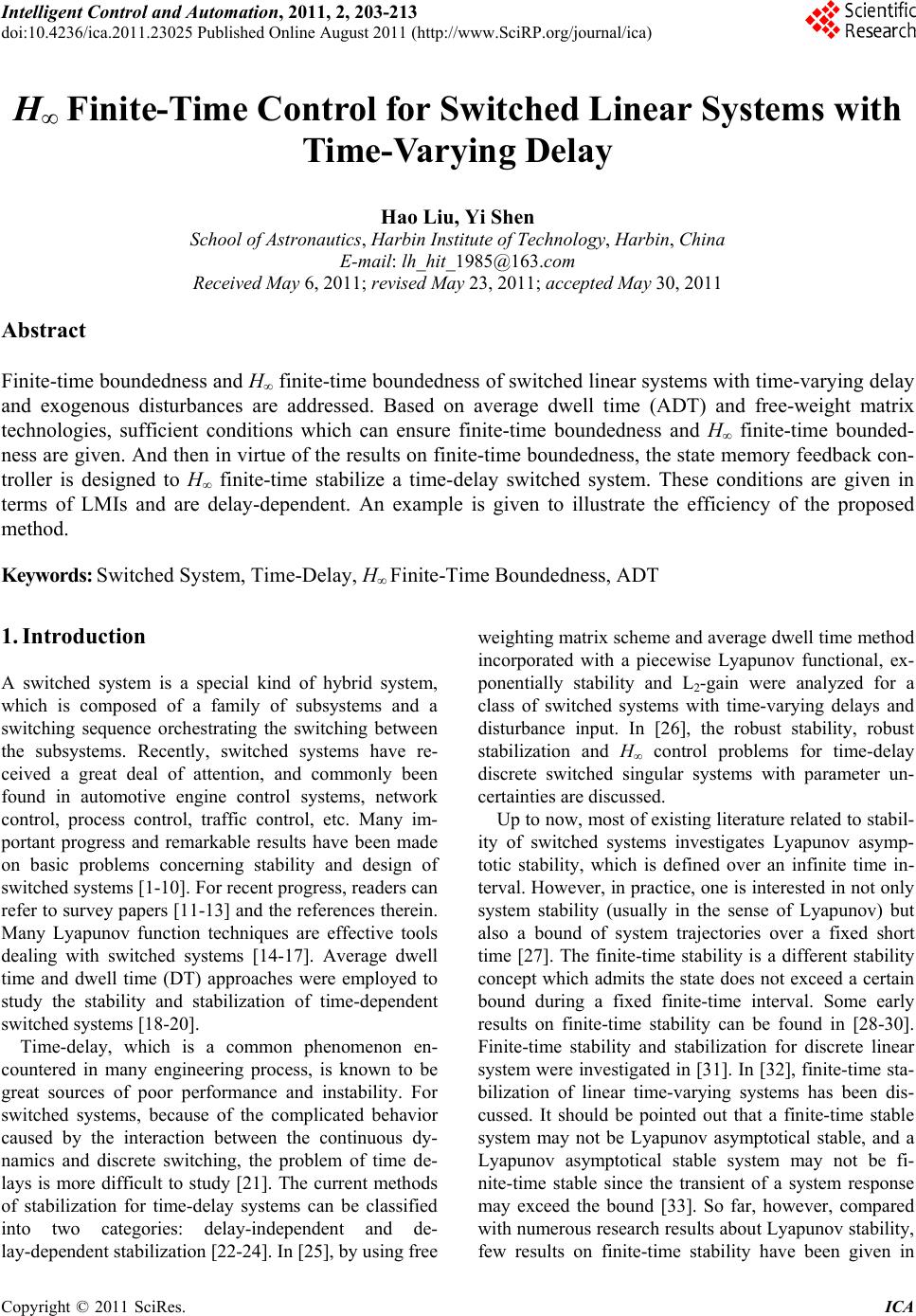 Intelligent Control and Automation, 2011, 2, 203-213 doi:10.4236/ica.2011.23025 Published Online August 2011 (http://www.SciRP.org/journal/ica) Copyright © 2011 SciRes. ICA H∞ Finite-Time Control for Switched Linear Systems with Time-Varying Delay Hao Liu, Yi Shen School of Astronautics, Harbin Institute of Technology, Harbin, China E-mail: lh_hit_1985@163.com Received May 6, 2011; revised May 23, 2011; accepted May 30, 2011 Abstract Finite-time boundedness and H∞ finite-time boundedness of switched linear systems with time-varying delay and exogenous disturbances are addressed. Based on average dwell time (ADT) and free-weight matrix technologies, sufficient conditions which can ensure finite-time boundedness and H∞ finite-time bounded- ness are given. And then in virtue of the results on finite-time boundedness, the state memory feedback con- troller is designed to H∞ finite-time stabilize a time-delay switched system. These conditions are given in terms of LMIs and are delay-dependent. An example is given to illustrate the efficiency of the proposed method. Keywords: Switched System, Time-Delay, H∞ Finite-Time Boundedness, ADT 1. Introduction A switched system is a special kind of hybrid system, which is composed of a family of subsystems and a switching sequence orchestrating the switching between the subsystems. Recently, switched systems have re- ceived a great deal of attention, and commonly been found in automotive engine control systems, network control, process control, traffic control, etc. Many im- portant progress and remarkable results have been made on basic problems concerning stability and design of switched systems [1-10]. For recent progress, readers can refer to survey papers [11-13] and the references therein. Many Lyapunov function techniques are effective tools dealing with switched systems [14-17]. Average dwell time and dwell time (DT) approaches were employed to study the stability and stabilization of time-dependent switched systems [18-20]. Time-delay, which is a common phenomenon en- countered in many engineering process, is known to be great sources of poor performance and instability. For switched systems, because of the complicated behavior caused by the interaction between the continuous dy- namics and discrete switching, the problem of time de- lays is more difficult to study [21]. The current methods of stabilization for time-delay systems can be classified into two categories: delay-independent and de- lay-dependent stabilization [22-24]. In [25], by using free weighting matrix scheme and average dwell time method incorporated with a piecewise Lyapunov functional, ex- ponentially stability and L2-gain were analyzed for a class of switched systems with time-varying delays and disturbance input. In [26], the robust stability, robust stabilization and H∞ control problems for time-delay discrete switched singular systems with parameter un- certainties are discussed. Up to now, most of existing literature related to stabil- ity of switched systems investigates Lyapunov asymp- totic stability, which is defined over an infinite time in- terval. However, in practice, one is interested in not only system stability (usually in the sense of Lyapunov) but also a bound of system trajectories over a fixed short time [27]. The finite-time stability is a different stability concept which admits the state does not exceed a certain bound during a fixed finite-time interval. Some early results on finite-time stability can be found in [28-30]. Finite-time stability and stabilization for discrete linear system were investigated in [31]. In [32], finite-time sta- bilization of linear time-varying systems has been dis- cussed. It should be pointed out that a finite-time stable system may not be Lyapunov asymptotical stable, and a Lyapunov asymptotical stable system may not be fi- nite-time stable since the transient of a system response may exceed the bound [33]. So far, however, compared with numerous research results about Lyapunov stability, few results on finite-time stability have been given in 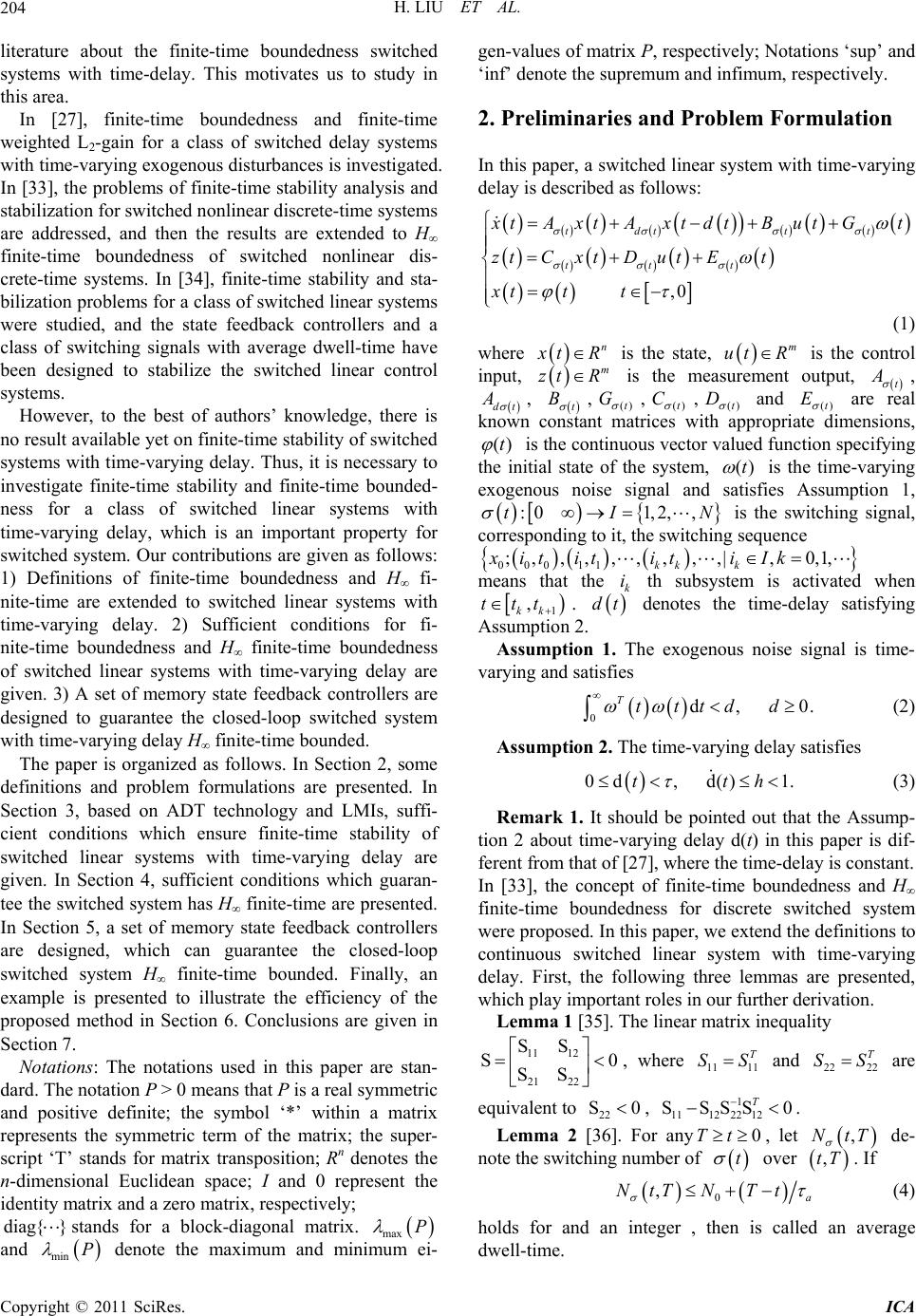 H. LIU ET AL. 204 literature about the finite-time boundedness switched systems with time-delay. This motivates us to study in this area. In [27], finite-time boundedness and finite-time weighted L2-gain for a class of switched delay systems with time-varying exogenous disturbances is investigated. In [33], the problems of finite-time stability analysis and stabilization for switched nonlinear discrete-time systems are addressed, and then the results are extended to H∞ finite-time boundedness of switched nonlinear dis- crete-time systems. In [34], finite-time stability and sta- bilization problems for a class of switched linear systems were studied, and the state feedback controllers and a class of switching signals with average dwell-time have been designed to stabilize the switched linear control systems. However, to the best of authors’ knowledge, there is no result available yet on finite-time stability of switched systems with time-varying delay. Thus, it is necessary to investigate finite-time stability and finite-time bounded- ness for a class of switched linear systems with time-varying delay, which is an important property for switched system. Our contributions are given as follows: 1) Definitions of finite-time boundedness and H∞ fi- nite-time are extended to switched linear systems with time-varying delay. 2) Sufficient conditions for fi- nite-time boundedness and H ∞ finite-time boundedness of switched linear systems with time-varying delay are given. 3) A set of memory state feedback controllers are designed to guarantee the closed-loop switched system with time-varying delay H∞ finite-time bounded. The paper is organized as follows. In Section 2, some definitions and problem formulations are presented. In Section 3, based on ADT technology and LMIs, suffi- cient conditions which ensure finite-time stability of switched linear systems with time-varying delay are given. In Section 4, sufficient conditions which guaran- tee the switched system has H∞ finite-time are presented. In Section 5, a set of memory state feedback controllers are designed, which can guarantee the closed-loop switched system H∞ finite-time bounded. Finally, an example is presented to illustrate the efficiency of the proposed method in Section 6. Conclusions are given in Section 7. Notations: The notations used in this paper are stan- dard. The notation P > 0 means that P is a real symmetric and positive definite; the symbol ‘*’ within a matrix represents the symmetric term of the matrix; the super- script ‘T’ stands for matrix transposition; Rn denotes the n-dimensional Euclidean space; I and 0 represent the identity matrix and a zero matrix, respectively; stands for a block-diagonal matrix. diag{} max P and denote the maximum and minimum ei- gen-values of matrix P, respectively; Notations ‘sup’ and ‘inf’ denote the supremum and infimum, respectively. P min 2. Preliminaries and Problem Formulation In this paper, a switched linear system with time-varying delay is described as follows: ,0 tdtt t ttt tAxtAxtdt ButGt ztCxtDut Et xt tt (1) where n tR is the state, is the control input, m ut R m zt R is the measurement output, t , dt , t,()t,()t,()t and ()t are real known constant matrices with appropriate dimensions, A ()t B G C D E is the continuous vector valued function specifying the initial state of the system, ()t is the time-varying exogenous noise signal and satisfies Assumption 1, N:0tI 1,2,, is the switching signal, corresponding to it, the switching sequence 00011 ;, ,,,,,,,|,0,1, kk k xitititi Ik k i means that the th subsystem is activated when 1 , kk ttt . dt denotes the time-delay satisfying Assumption 2. Assumption 1. The exogenous noise signal is time- varying and satisfies 0d, 0 Ttttd d . (2) Assumption 2. The time-varying delay satisfies 0d, d()1.tth (3) Remark 1. It should be pointed out that the Assump- tion 2 about time-varying delay d(t) in this paper is dif- ferent from that of [27], where the time-delay is constant. In [33], the concept of finite-time boundedness and H∞ finite-time boundedness for discrete switched system were proposed. In this paper, we extend the definitions to continuous switched linear system with time-varying delay. First, the following three lemmas are presented, which play important roles in our further derivation. Lemma 1 [35]. The linear matrix inequality 11 12 21 22 SS S0 SS 22 , where and are equivalent to 11 11 T SS22 22 T SS S0 , 1 1222 12 SSSS T 11 0 . Lemma 2 [36]. For any, let 0Tt ,NtT de- note the switching number of t over . If ,tT 0 ,a NtT NTt (4) holds for and an integer , then is called an average dwell-time. Copyright © 2011 SciRes. ICA 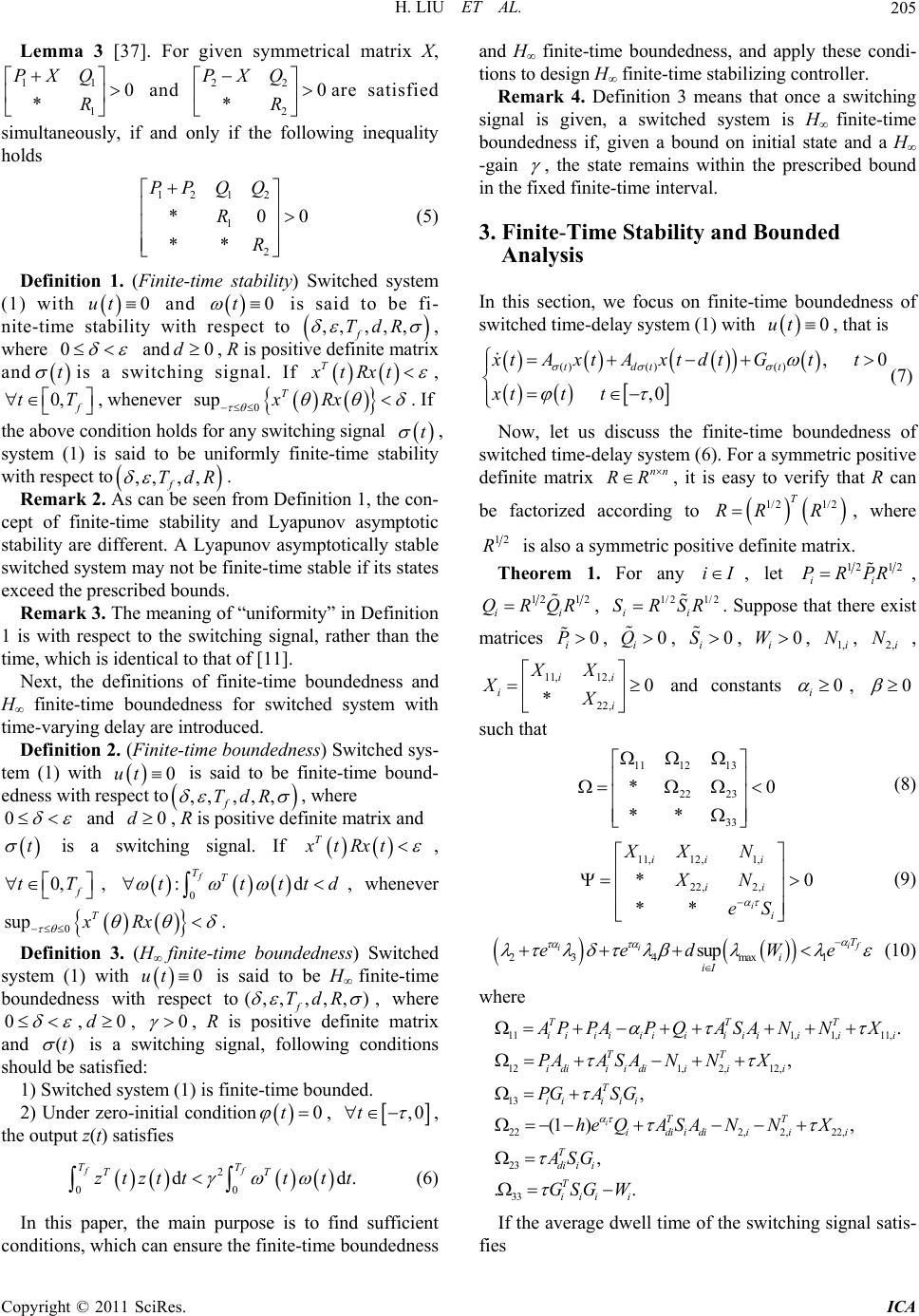 H. LIU ET AL.205 0 Lemma 3 [37]. For given symmetrical matrix X, 11 1 0 * PXQ R and are satisfied 22 2 0 * PXQ R simultaneously, if and only if the following inequality holds 12 1 2 1 2 *0 ** PPQQ R R (5) Definition 1. (Finite-time stability) Switched system (1) with and is said to be fi- nite-time stability with respect to 0ut 0t ,,,,, f TdR , where 0 and, R is positive definite matrix and is a switching signal. If 0d t T xtRxt , 0, t T , whenever xRx 0 T sup . If the above condition holds for any switching signal t , system (1) is said to be uniformly finite-time stability with respect to. ,, ,, f TdR Remark 2. As can be seen from Definition 1, the con- cept of finite-time stability and Lyapunov asymptotic stability are different. A Lyapunov asymptotically stable switched system may not be finite-time stable if its states exceed the prescribed bounds. Remark 3. The meaning of “uniformity” in Definition 1 is with respect to the switching signal, rather than the time, which is identical to that of [11]. Next, the definitions of finite-time boundedness and H∞ finite-time boundedness for switched system with time-varying delay are introduced. Definition 2. (Finite-time boundedness) Switched sys- tem (1) with is said to be finite-time bound- edness with respect to 0ut ,,,,, f TdR , where 0 and , R is positive definite matrix and 0d t is a switching signal. If T xtRxt , 0, tT 0 T sup , , whenever 0 : f TT tt xRx dttd . Definition 3. (H∞ finite-time boundedness) Switched system (1) with is said to be H∞ finite-time boundedness with respect to 0ut (,,,,, ) f TdR , where 0 ,, 0d0 , R is positive definite matrix and ()t is a switching signal, following conditions should be satisfied: 1) Switched system (1) is finite-time bounded. 2) Under zero-initial condition, 0t ,0t , the output z(t) satisfies 2 00 dd ff TT TT ztzttt tt . (6) In this paper, the main purpose is to find sufficient conditions, which can ensure the finite-time boundedness and H∞ finite-time boundedness, and apply these condi- tions to design H∞ finite-time stabilizing controller. Remark 4. Definition 3 means that once a switching signal is given, a switched system is H∞ finite-time boundedness if, given a bound on initial state and a H∞ -gain , the state remains within the prescribed bound in the fixed finite-time interval. 3. Finite-Time Stability and Bounded Analysis In this section, we focus on finite-time boundedness of switched time-delay system (1) with , that is 0ut ()()() ,0 ,0 tdt t xtAxtAxt dtGtt xtt t (7) Now, let us discuss the finite-time boundedness of switched time-delay system (6). For a symmetric positive definite matrix nn RR , it is easy to verify that R can be factorized according to , where 1/21/2 T RR R 12 R is also a symmetric positive definite matrix. Theorem 1. For any i, let I1212 ii PRPR, 12 12 ii QRQR, . Suppose that there exist matrices , , , , , , 1/ 2 i SR 0 i Q 2, , 0 ii i 1/ 2 i SR 0 i S 0 i P 11, 1 22 XX X 0 i W1,i N2,i N * i X and constants 0 i , 0 such that 11 1213 22 23 33 * ** 0 (8) 11, 12,1, 22, 2, *0 ** i ii i ii i XX N XN eS (9) 234max1 sup if ii T i iI eedWe (10) where 111, 1,11, 121, 2,12, 13 222, 2,22, 23 33 . , , (1 ), , .. i TT iiiiiiiiii iii TT idiiidiiii T iii ii TT idiidiii i T di ii T iii i T PPAPQASAN NX PAAS ANNX PGAS G he QASANNX ASG GSG W If the average dwell time of the switching signal satis- fies Copyright © 2011 SciRes. ICA  H. LIU ET AL. 206 * 123 4 ln ln lnii aa f T ee (11) then the switched systems is finite-time boundedness with respect to (,,,,,) f TdR , where 1 , max sup iI dW 0ln if TN ij PP , , ij QQ , ij SS ,ij I, , iI i max , 1mi infiI i P n 2 supiI maxi P , 3max supiI i Q , 4max supiI i S . Proof. Choose a Lyapunov-like function as follows 1, 2,3,iiii VtVtVtVt Vt (12) where 1, () 2, () 0() 3, , d, dd. i i T ii tts T ii tdt tts T ii t Vt xtPxt Vte xsQxss Vte xsSxss When , taking the derivative of V(t) with respect to t along the trajectory of switched system (7), we have 1 , kk ttt 1, TT ii TT ii ii TT di i T idi TT ii T ii VtxtPxtxtPxt xtAPPAxt xtdtAPxt xtPAxtdt tGPxt xtPGt i (13) 2, 2, () 2, 1 1 i i T iii i dt T i T ii i T i VtVt xtQxt dt extdt Qxt dt Vt xtQxt he xtdt Qxtdt (14) 3, 3, 0 3, () d d i i T iiii T i T ii i tst T i t VtVt xtSxt ext Sxt Vt xtSxt exsSxss (15) From the Leibniz-Newton formula, the following equation is true for any matrices , , 1, i N2,i N iI with appropriate dimensions 1, 2, () 2d d0 i TT i t tdt N xsxtsN xtxtdtxs s (16) For any matrices , with appropriate dimensions, we have 0 i X iI 1111 () d0 t TT ii tdt tXtsXs s (17) where 1 T TT txtxtdt . Then, it follows from (13)-(17) that 1, 2,3, 11 1213 22 23 33 () 1, 2, () 11 () 2 * ** 2 d d i iiiii T tstT i t TT ii t tdt tTT ii tdt Vt VtVtVtVt Vt xt xt xt dtxt dt tt exsSxsds xtN xtdtN xs s sXs stWt 2 33 () ,,d T tTT i tdt tt tsts stWt (18) Assuming conditions (8) and (9) are satisfied, we ob- tain T i VtVttW t i (19) By calculation, we have () () () () d tk k k tk k k tt tk tts T t t Vt eVt esW ss (20) Since 1 , ij PP , ij QQ , i SS j and 12 PR12 ii PR , 12 12 ii QRQR, 12 i SR j 12 i SR , then , , , , iji ij PPQQ SS ijI (21) Assume that k t i and at switching instant . According to (19), we obtain k t j k t kk k tt Vt Vt k (22) For any 0, tT, let N be the switching number of σ(t) over (0, Tf ). Using the iterative method, we have Copyright © 2011 SciRes. ICA 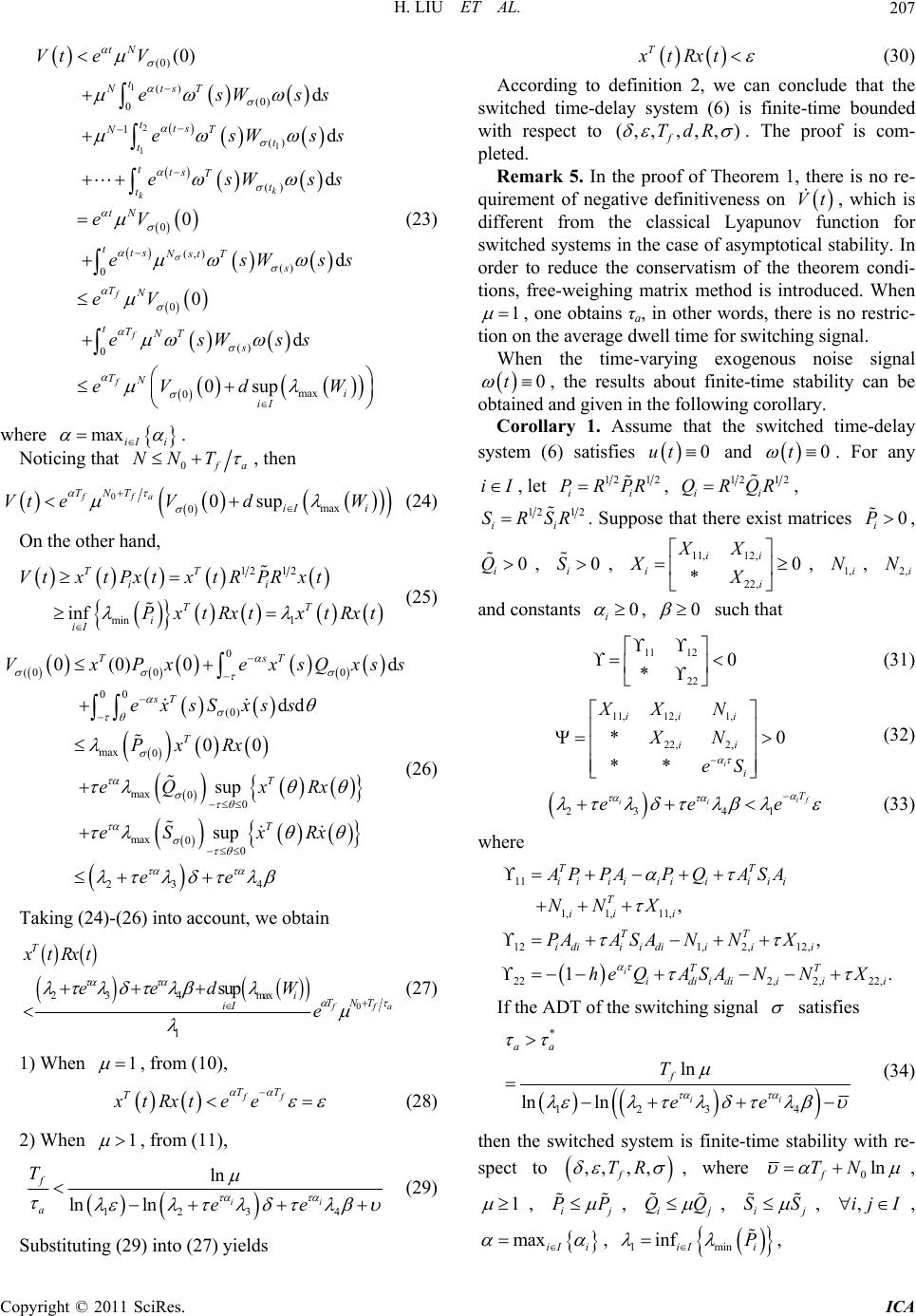 H. LIU ET AL.207 1 2 1 1 (0) () (0) 0 1 () () 0 (,) () 0 0 () 0 max 0 (0) d d d 0 d 0 d 0sup k k f f f tN t NtsT tts NT t t tts T t t tN ttsNst T s TN tTNT s TN i iI Vt eV esWss esWss esWss eV esW eV esWss eV dW ss (23) where maxiI i . Noticing that 0fa NNT , then 0 max 00sup ffa TNT iI i Vt eVdW (24) On the other hand, 1212 min 1 inf TT ii TT i iI VtxtPxtx tRPRxt PxtRxt xtRxt (25) 0 (0 00 00 (0) max 0 max 00 max 00 23 4 0(0) 0 dd 00 sup sup TsT sT T T T VxPxexsQx exsS xss Px Rx eQ xRx eS xRx ee dss (26) Taking (24)-(26) into account, we obtain 0 23 4max 1 sup fa T iTNT iI xtRxt eedW e (27) 1) When 1 , from (10), ff TT T xtRxte e (28) 2) When 1 , from (11), 123 4 ln ln lnii f a T ee (29) Substituting (29) into (27) yields T xtRxt (30) According to definition 2, we can conclude that the switched time-delay system (6) is finite-time bounded with respect to ( ,,,,,) f TdR . The proof is com- pleted. Remark 5. In the proof of Theorem 1, there is no re- quirement of negative definitiveness on , which is different from the classical Lyapunov function for switched systems in the case of asymptotical stability. In order to reduce the conservatism of the theorem condi- tions, free-weighing matrix method is introduced. When Vt 1 , one obtains τa, in other words, there is no restric- tion on the average dwell time for switching signal. When the time-varying exogenous noise signal 0t , the results about finite-time stability can be obtained and given in the following corollary. Corollary 1. Assume that the switched time-delay system (6) satisfies 0ut and . For any 0t iI , let 12 ii PRP12 R , 12 i QR12 i QR , 12 12 i SR 0 i Q i SR . Suppose that there exist matrices , , , 0 i P 0 i S 11,12, 22, 0 * ii i i XX XX 0 , , and constants 1, i N2,i N i , 0 such that 11 12 22 0 * (31) 11, 12,1, 22, 2, *0 ** i iii ii i XXN XN eS (32) 23 41 if ii T eee (33) where 11 1, 1,11, 121,2,12, 222, 2,22, , , 1. i TT i iiiiiiiii T ii i TT idiiidiiii TT idiidiii APPAP QASA NN X PAAS ANNX he QASANNX i If the ADT of the switching signal satisfies * 123 4 ln ln lnii aa f T ee (34) then the switched system is finite-time stability with re- spect to ,,,, f TR , where 0ln f TN , 1 , ij PP , ij QQ , ij SS , ,ij I , iIi max 1 inf , , mini P iI Copyright © 2011 SciRes. ICA  H. LIU ET AL. 208 2max sup iI i P 4max sup iI i S , , . 3max sup iI i Q ut Remark 6. It is easy to find that some differences be- tween Lyapunov asymptotical stability and finite-time stability. Conditions (33) and (34) must be satisfied for finite-time stability, which is not necessary for asymp- totical stability. Thus, the two concepts are independent. However, in previous research, there are few results on finite-time stability, which needs our full investigation. 4. H∞ Finite-Time Boundedness Analysis In this section, we discuss H∞ finite-time boundedness of switched time-delay system (1) with . First, consider the following switched time-delay system 0 () () () [,0] tdt tt t () () tAxt ztC xt xtt t Axtdt G E t I t (35) Theorem 2. For any i , let 1212 ii PRPR , 1212 ii QRQR, 12 12 i 0 N i SR 0 i S 1, i2, N SR 0 i P i Q 11, 12, 22, 0 * ii i i XX XX . Suppose that there exist matrices , , , , , and constants i0 i and 0 11 12 22 ** ii CC 11, i such that 13 23 2 *0 TT ii TT iiii i CE IGSGEE (36) 12, 1, 22, 2, *0 ** i ii i ii i XXN XN eS (37) 2 41 if T ede (38) If the ADT of the switching signal satisfies * ln aa 2 10 ln ln ln f f T dTN (0,, (39) then the switched systems is H∞ finite-time boundedness with respect to , ,,) f TdR , where 1 , ij PP ij QQ, , ij SS , , ,ijI maxiI i 2max sup iI i P 4max sup iI i S , , , , . mini P iI 1 infiI 3 sup maxi Q Proof. Assuming condition (36) is satisfied, then we obtain 11 1213 22 23 2 * ** 0 *000 ** T iii TT ii ii T ii GSG CC CE EE (40) Since 0 *0000 ** T TT iiii i ii T ii i CCCEC CE EE E 0 (41) which implies that 11 1213 22 23 2 *0 ** T iii IGSG (42) From Theorem 1, conditions (37)-(39) can ensure that the switched time-delay system (35) is finite-time bounded with respect to (0, ,,,,) f TdR . Next, we will prove condition (6) is satisfied under zero initial condition. Choose the following Lyapunov function 1, 2, 3,iiii VtVtVtVt Vt , where 1, () 2, () 0 3, , d, dd . i i T ii tts T ii tdt ttsT ii t Vt xtPxt Vte xsQxss Vte xsSxss When 1 , kk ttt , by virtue of (36), we can obtain () 2 () (()()()())d ()d k tk k tk k k tt kk kk tt k t tts TT t t tt ts k tt Vt eVt esszsz eVte s ss s (43) Since 1 , ij PP , ij QQ , i SS j and 12 PR12 ii PR , 1212 ii QRQR, 12 12 ii SRSR ,jI , then ,,, jij QS Si iji PPQ . In what follows, assume that k ti and at switching instant . We have k tj k t kk k tt Vt Vt k (44) Since max i iI , then it follows from (43) and (44) that Copyright © 2011 SciRes. ICA 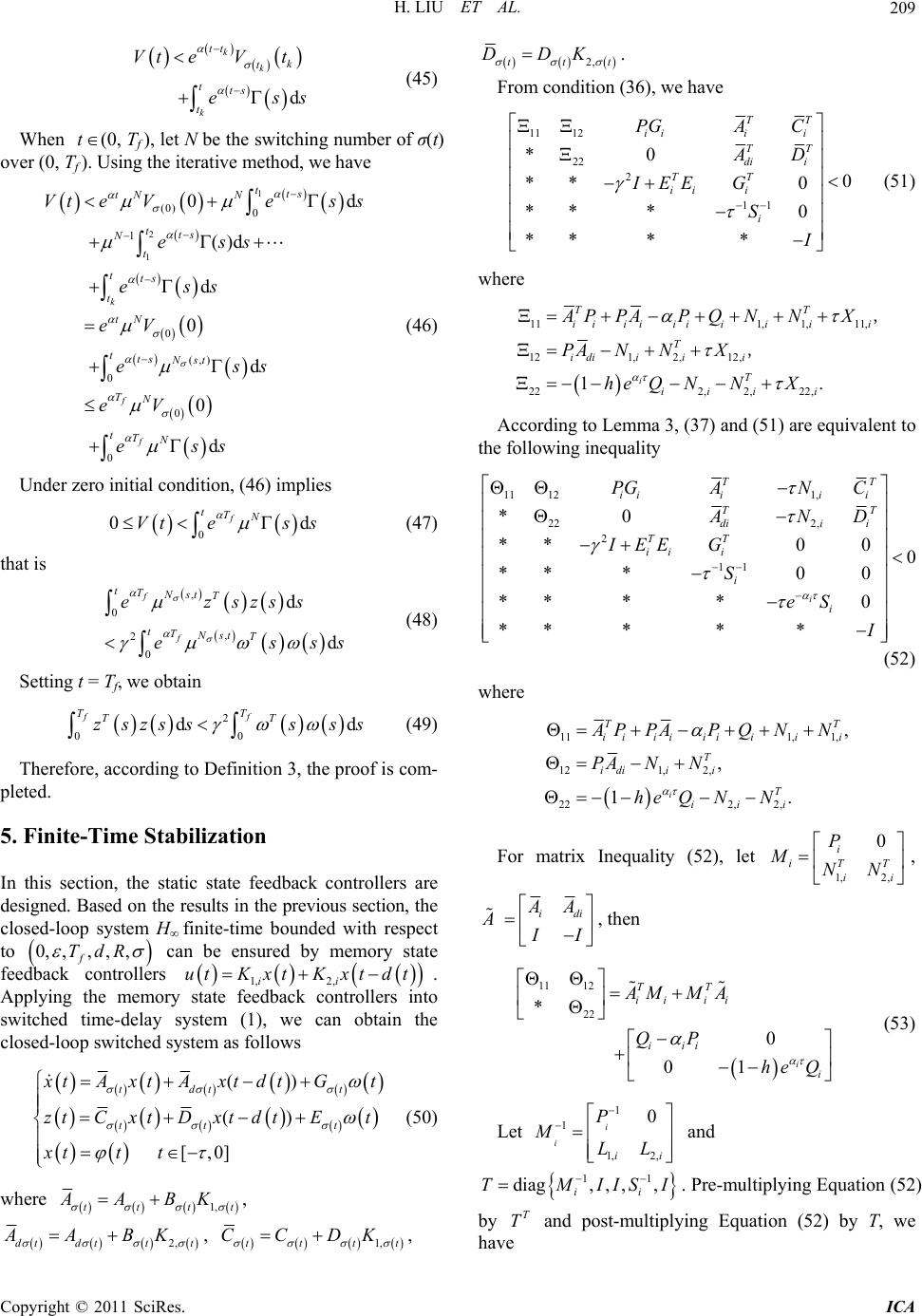 H. LIU ET AL.209 s ss ∞ d k k k tt k t tts t Vt eVt es (45) When (0, Tf ), let N be the switching number of σ(t) over (0, Tf ). Using the iterative method, we have t 1 2 1 (0) 0 1 0 (,) 0 0 0 0d ()d d 0 d 0 d k f f tts tN N tts N t tts t tN tts Nst TN tTN VteVes s ess ess eV ess eV ess (46) Under zero initial condition, (46) implies 0 0d f tTN Vtes s (47) that is , 0 , 2 0 d d f f tTNst T tTNst T ezszss es (48) Setting t = Tf, we obtain 2 00 dd ff TT TT zszsss ss (49) Therefore, according to Definition 3, the proof is com- pleted. 5. Finite-Time Stabilization In this section, the static state feedback controllers are designed. Based on the results in the previous section, the closed-loop system Hfinite-time bounded with respect to 0, ,,,, f TdR can be ensured by memory state feedback controllers 1, 2,ii utK xtKxtdt. Applying the memory state feedback controllers into switched time-delay system (1), we can obtain the closed-loop switched system as follows () () [,0] tdt t tt t tAxtAxtdt Gt ztCxtDxt dtEt xtt t (50) where 1,ttt AABK t , 2,dt dttt AABK , 1,ttt CCDK t , 2,tt DDK t . From condition (36), we have 11 12 22 2 11 *0 0 ** 0 ** *0 ** ** TT iii i TT di i TT ii i i PGA C AD IEE G S I (51) where 111, 1,11, 121,2,12, 222, 2,22, 1. i TT iiiiiiiii T idi iii T iii i APPAPQNNX PA NNX he QNNX , , i According to Lemma 3, (37) and (51) are equivalent to the following inequality 11 121, 22 2, 2 11 *0 **0 00 ***00 ** **0 ** *** i TT iiii i TT dii i TT ii i i i PGAN C AND IEE G S eS I (52) where 111, 1, 121,2, 222, 2, , , 1. i TT iiiiiiiii T idi ii T iii PPAPQNN PA NN he QNN For matrix Inequality (52), let , 1, 2, 0 i TT i ii P MNN idi A A I , then 11 12 22 * 0 01 i TT ii ii iii i AMMA QP he Q (53) Let 1 1 1, 2, 0 i i ii P MLL and 11 ag,, ,, ii TMIIS di T T I. Pre-multiplying Equation (52) by and post-multiplying Equation (52) by T, we ave h Copyright © 2011 SciRes. ICA 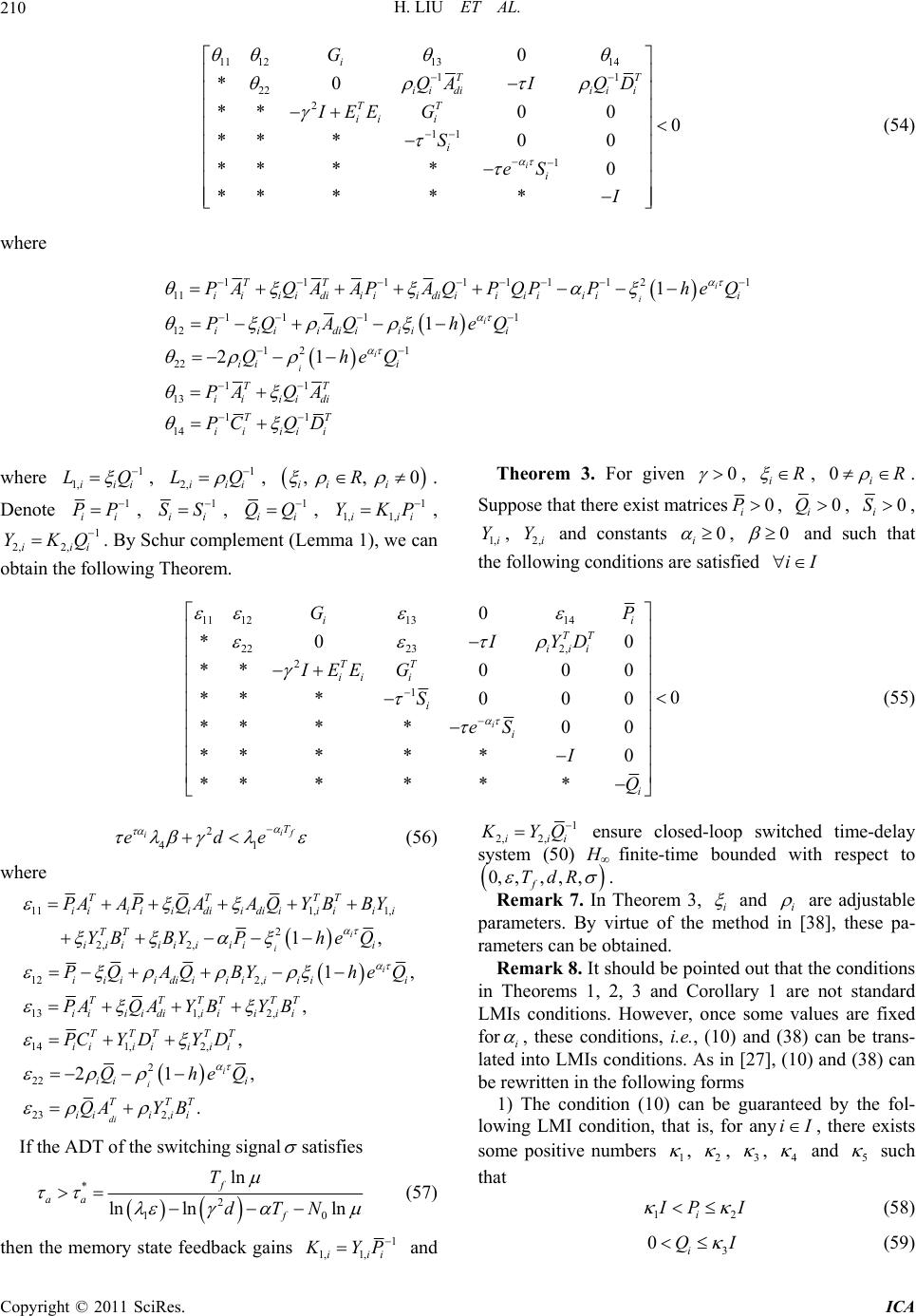 H. LIU ET AL. Copyright © 2011 SciRes. ICA 210 11 121314 11 22 2 11 1 0 *0 **000 ** *00 ** **0 ** *** i i TT ii diiii TT ii i i i G QAI QD IEE G S eS I (54) where 11 111112 11 11 11 12 121 22 11 13 11 14 1 1 21 i i i i i TT iiii diiiidiiiiiiii iiiidiiiii ii i TT ii iidi TT ii iii PAQAAPAQPQPPhe Q PQ AQheQ QheQ PA QA PC QD 1 where , 1 1,iii LQ 1 2,iii Q , . Denote , , 0 ii i R 1 ii PP , 1 ii SS , 1 ii Q 1 1, 1,iii YKPQ, , . By Schur complement (Lemma 1), we can obtain the following Theorem. 1 2,ii Q 2,i YK Theorem 3. For given 0 , iR , 0iR . Suppose that there exist matrices0 i P, 0 i Q, 0 i S, , and constants 1, i Y2,i Y0 i , 0 and such that the following conditions are satisfied iI 11 121314 2223 2, 2 1 0 *0 0 **00 0 0 ***00 0 ****0 0 ** ** *0 ** ** ** i ii TT iii TT ii i i i i GP IYD IEE G S eS I Q (55) 2 41 if iT ede (56) where 111, 1, 2 2, 2, 12 2, 131, 2, 141,2, 1, 1, , i i i TTTT iiiiiidi idiiiiii TT iiiiiiiii iiiidiiiiiii i TTTTTT ii iidi ii iii TTT iii iii PAAPQ AAQYBBY YBBYPhe Q PQ AQBYheQ PAQAYBYB PCY DY 2 22 23 2, , 21, . i i di TT i ii i TTT iii ii D QheQ QAY B If the ADT of the switching signal satisfies * 2 10 ln ln lnln f aa f T dTN (57) then the memory state feedback gains 1 1, 1,iii YP and 1 2, 2,iii YQ ensure closed-loop switched time-delay system (50) H finite-time bounded with respect to ∞ 0, ,,,, f TdR . Remark 7. In Theorem 3, i and i are adjustable parameters. By virtue of the method in [38], these pa- rameters can be obtained. Remark 8. It should be pointed out that the conditions in Theorems 1, 2, 3 and Corollary 1 are not standard LMIs conditions. However, once some values are fixed for i , these conditions, i.e., (10) and (38) can be trans- lated into LMIs conditions. As in [27], (10) and (38) can be rewritten in the following forms 1) The condition (10) can be guaranteed by the fol- lowing LMI condition, that is, for any, there exists some positive numbers iI 1 , , , and 2 3 4 5 such that 1i2 PI (58) 3 0i Q I (59)  H. LIU ET AL.211 I I 4 0i S (60) 5 0i W (61) 23 451 if ii T eede (62) 2) The condition (38) can be guaranteed by the fol- lowing LMI condition, that is, for any, there exists some positive numbers , , and satisfying (58)-(60) such that iI 1 2 3 4 23 41 if ii T eee . (63) 6. Numerical Simulation and Results In this section, for given and , an example is em- ployed to verify the method proposed above. Consider a switched linear system with time-varying delay as fol- lows () ()()tdt t tAxtAxtdt Gt (64) with , , , , , , 1 1.7 1.70 1.31 0.7 0.7 10.6 A 1.51.70.1 1.3 10.3 0.7 10.6 1 G 0.7 0 0 2 10 1.3 0.1 1.5 0.1 d A 2 110 0.7 00.6 1.7 01.7 A 1 1 1 0.1 0.6 1.8 1d A ()xt ,0th, , 21 GG 0.2 0.02h, . The values of , T, and are selected as follows: d R 0.5 , , , , 10 f T0.01dRI0.05 i , 0.01 . When 2 and 30 , by virtue of Theorem 1, one obtains a. For any switching signal * 2.4659 t with average dwell time a * a 2s , switched linear system with time-delay is finite-time bounded with re- spect to (0.5, 30, 10, 0.01, I, σ). The state trajectory over 0~10 s under a periodic switching signal with interval time is shown in Figure 1. It is obvious that switched linear system (64) is finite-time bounded. The state trajectory over 0 ~ 10 s under a periodic switching signal with interval time is shown in Figure 2. As can be seen from figure 2, switched linear system (64) is not finite-time bounded any more. 2.5T s T 7. Conclusions In this paper, unlike most existing research results fo- 0123 45678910 -2 -1. 5 -1 -0. 5 0 0.5 1 1.5 Time /s Trajectories x 1 x 2 x 3 Figure 1. The histories of the state trajectory of switched system under a periodic switching signal with interval time ΔT = 2.5s. 0 123 4 5 67 8910 -8 -6 -4 -2 0 2 4 6 Time/s Traject ories x 1 x 2 x 3 Figure 2. The histories of the state trajectory of switched system under a periodic switching signal with interval time ΔT = 2s. cusing on Lyapunov stability property of switched time-varying delay system, we mainly discuss finite-time boundedness and H∞ finite-time boundedness of switched linear systems with time-varying delay. As the main contribution of this paper, sufficient conditions which can guarantee finite-time boundedness and H∞ finite-time boundedness of switched linear systems with time-varying delay are proposed. And then based on the results on finite-time boundedness, the memory state feedback controller is designed to H∞ finite-time stabilize a switched linear system with time-varying delay. An important and challenging further investigation is how to extend the results in this paper to uncertain switched systems and switched nonlinear systems. 8. Acknowledgements The authors would like to thank the Editor-in-Chief, the Associate Editor, and the reviewers for their insightful and constructive comments, which help to enrich the content and improve the presentation of this paper. 9. References [1] J. Liu, X. Z. Liu and W. C. Xie, “Delay-Dependent Ro- bust Control for Uncertain Switched Systems with Time-Delay,” Nonlinear Analysis: Hybrid Systems, Vol. 2, Copyright © 2011 SciRes. ICA 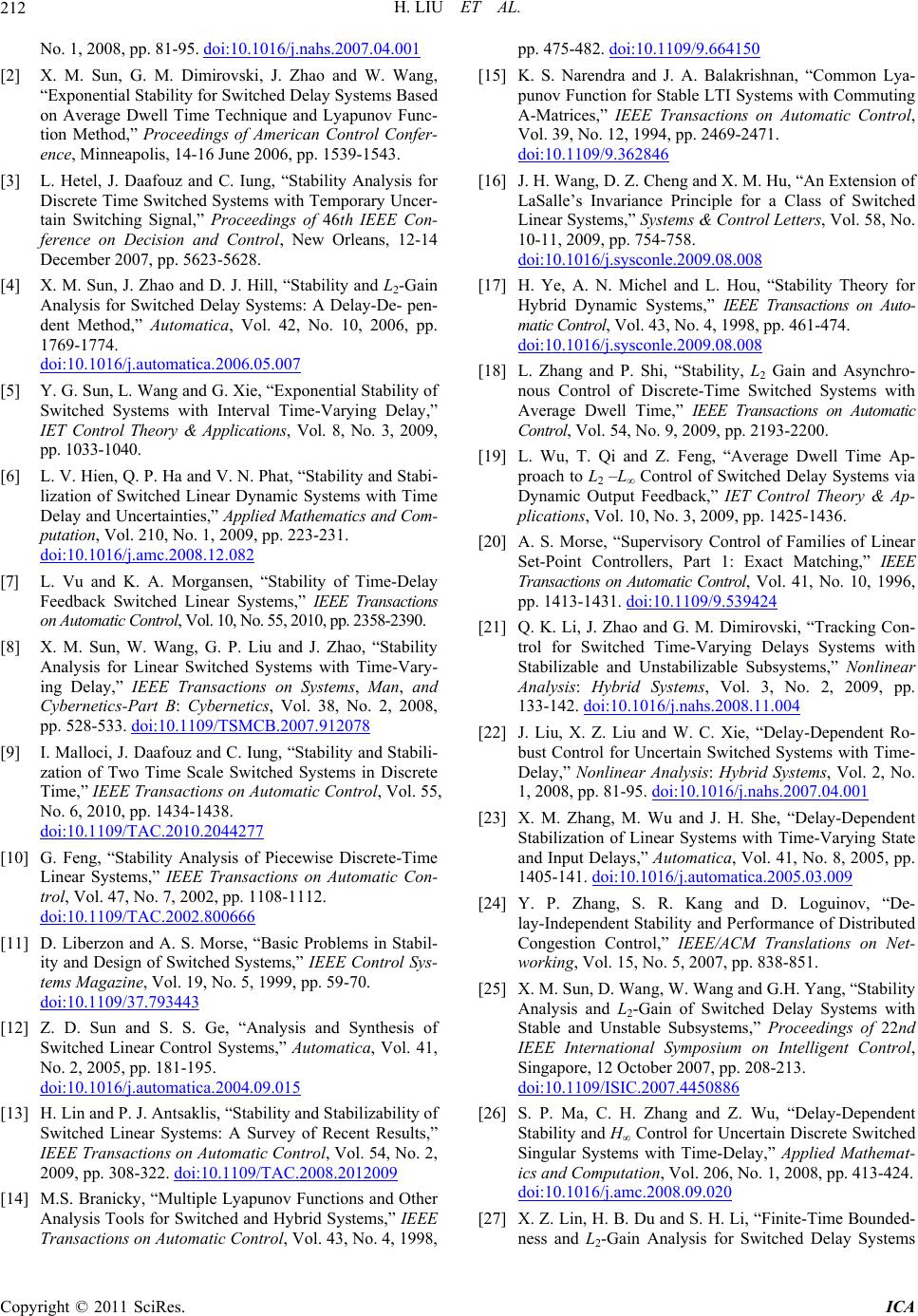 H. LIU ET AL. 212 No. 1, 2008, pp. 81-95. doi:10.1016/j.nahs.2007.04.001 [2] X. M. Sun, G. M. Dimirovski, J. Zhao and W. Wang, “Exponential Stability for Switched Delay Systems Based on Average Dwell Time Technique and Lyapunov Func- tion Method,” Proceedings of American Control Confer- ence, Minneapolis, 14-16 June 2006, pp. 1539-1543. [3] L. Hetel, J. Daafouz and C. Iung, “Stability Analysis for Discrete Time Switched Systems with Temporary Uncer- tain Switching Signal,” Proceedings of 46th IEEE Con- ference on Decision and Control, New Orleans, 12-14 December 2007, pp. 5623-5628. [4] X. M. Sun, J. Zhao and D. J. Hill, “Stability and L2-Gain Analysis for Switched Delay Systems: A Delay-De- pen- dent Method,” Automatica, Vol. 42, No. 10, 2006, pp. 1769-1774. doi:10.1016/j.automatica.2006.05.007 [5] Y. G. Sun, L. Wang and G. Xie, “Exponential Stability of Switched Systems with Interval Time-Varying Delay,” IET Control Theory & Applications, Vol. 8, No. 3, 2009, pp. 1033-1040. [6] L. V. Hien, Q. P. Ha and V. N. Phat, “Stability and Stabi- lization of Switched Linear Dynamic Systems with Time Delay and Uncertainties,” Applied Mathematics and Com- putation, Vol. 210, No. 1, 2009, pp. 223-231. doi:10.1016/j.amc.2008.12.082 [7] L. Vu and K. A. Morgansen, “Stability of Time-Delay Feedback Switched Linear Systems,” IEEE Transactions on Automatic Control, Vol. 10, No. 55, 2010, pp. 2358-2390. [8] X. M. Sun, W. Wang, G. P. Liu and J. Zhao, “Stability Analysis for Linear Switched Systems with Time-Vary- ing Delay,” IEEE Transactions on Systems, Man, and Cybernetics-Part B: Cybernetics, Vol. 38, No. 2, 2008, pp. 528-533. doi:10.1109/TSMCB.2007.912078 [9] I. Malloci, J. Daafouz and C. Iung, “Stability and Stabili- zation of Two Time Scale Switched Systems in Discrete Time,” IEEE Transactions on Automatic Control, Vol. 55, No. 6, 2010, pp. 1434-1438. doi:10.1109/TAC.2010.2044277 [10] G. Feng, “Stability Analysis of Piecewise Discrete-Time Linear Systems,” IEEE Transactions on Automatic Con- trol, Vol. 47, No. 7, 2002, pp. 1108-1112. doi:10.1109/TAC.2002.800666 [11] D. Liberzon and A. S. Morse, “Basic Problems in Stabil- ity and Design of Switched Systems,” IEEE Control Sys- tems Magazine, Vol. 19, No. 5, 1999, pp. 59-70. doi:10.1109/37.793443 [12] Z. D. Sun and S. S. Ge, “Analysis and Synthesis of Switched Linear Control Systems,” Automatica, Vol. 41, No. 2, 2005, pp. 181-195. doi:10.1016/j.automatica.2004.09.015 [13] H. Lin and P. J. Antsaklis, “Stability and Stabilizability of Switched Linear Systems: A Survey of Recent Results,” IEEE Transactions on Automatic Control, Vol. 54, No. 2, 2009, pp. 308-322. doi:10.1109/TAC.2008.2012009 [14] M.S. Branicky, “Multiple Lyapunov Functions and Other Analysis Tools for Switched and Hybrid Systems,” IEEE Transactions on Automatic Control, Vol. 43, No. 4, 1998, pp. 475-482. doi:10.1109/9.664150 [15] K. S. Narendra and J. A. Balakrishnan, “Common Lya- punov Function for Stable LTI Systems with Commuting A-Matrices,” IEEE Transactions on Automatic Control, Vol. 39, No. 12, 1994, pp. 2469-2471. doi:10.1109/9.362846 [16] J. H. Wang, D. Z. Cheng and X. M. Hu, “An Extension of LaSalle’s Invariance Principle for a Class of Switched Linear Systems,” Systems & Control Letters, Vol. 58, No. 10-11, 2009, pp. 754-758. doi:10.1016/j.sysconle.2009.08.008 [17] H. Ye, A. N. Michel and L. Hou, “Stability Theory for Hybrid Dynamic Systems,” IEEE Transactions on Auto- matic Control, Vol. 43, No. 4, 1998, pp. 461-474. doi:10.1016/j.sysconle.2009.08.008 [18] L. Zhang and P. Shi, “Stability, L2 Gain and Asynchro- nous Control of Discrete-Time Switched Systems with Average Dwell Time,” IEEE Transactions on Automatic Control, Vol. 54, No. 9, 2009, pp. 2193-2200. [19] L. Wu, T. Qi and Z. Feng, “Average Dwell Time Ap- proach to L2 –L∞ Control of Switched Delay Systems via Dynamic Output Feedback,” IET Control Theory & Ap- plications, Vol. 10, No. 3, 2009, pp. 1425-1436. [20] A. S. Morse, “Supervisory Control of Families of Linear Set-Point Controllers, Part 1: Exact Matching,” IEEE Transactions on Automatic Control, Vol. 41, No. 10, 1996, pp. 1413-1431. doi:10.1109/9.539424 [21] Q. K. Li, J. Zhao and G. M. Dimirovski, “Tracking Con- trol for Switched Time-Varying Delays Systems with Stabilizable and Unstabilizable Subsystems,” Nonlinear Analysis: Hybrid Systems, Vol. 3, No. 2, 2009, pp. 133-142. doi:10.1016/j.nahs.2008.11.004 [22] J. Liu, X. Z. Liu and W. C. Xie, “Delay-Dependent Ro- bust Control for Uncertain Switched Systems with Time- Delay,” Nonlinear Analysis: Hybrid Systems, Vol. 2, No. 1, 2008, pp. 81-95. doi:10.1016/j.nahs.2007.04.001 [23] X. M. Zhang, M. Wu and J. H. She, “Delay-Dependent Stabilization of Linear Systems with Time-Varying State and Input Delays,” Automatica, Vol. 41, No. 8, 2005, pp. 1405-141. doi:10.1016/j.automatica.2005.03.009 [24] Y. P. Zhang, S. R. Kang and D. Loguinov, “De- lay-Independent Stability and Performance of Distributed Congestion Control,” IEEE/ACM Translations on Net- working, Vol. 15, No. 5, 2007, pp. 838-851. [25] X. M. Sun, D. Wang, W. Wang and G.H. Yang, “Stability Analysis and L2-Gain of Switched Delay Systems with Stable and Unstable Subsystems,” Proceedings of 22nd IEEE International Symposium on Intelligent Control, Singapore, 12 October 2007, pp. 208-213. doi:10.1109/ISIC.2007.4450886 [26] S. P. Ma, C. H. Zhang and Z. Wu, “Delay-Dependent Stability and H∞ Control for Uncertain Discrete Switched Singular Systems with Time-Delay,” Applied Mathemat- ics and Computation, Vol. 206, No. 1, 2008, pp. 413-424. doi:10.1016/j.amc.2008.09.020 [27] X. Z. Lin, H. B. Du and S. H. Li, “Finite-Time Bounded- ness and L2-Gain Analysis for Switched Delay Systems Copyright © 2011 SciRes. ICA  H. LIU ET AL. Copyright © 2011 SciRes. ICA 213 with Norm-Bounded Disturbance,” Applied Mathematics and Computation, Vol. 217, No. 12, 2011, pp. 5982-5993. doi:10.1016/j.amc.2010.12.032 [28] L. Weiss and E. F. Infante, “Finite Time Stability under Perturbing Forces and on Product Spaces,” IEEE Trans- actions on Automatic Control, Vol. 12, No. 1, 1967, pp. 54-59. doi:10.1109/TAC.1967.1098483 [29] A. N. Michel and S. H. Wu, “Stability of Discrete Sys- tems over a Finite Interval of Time,” International Jour- nal of Control, Vol. 9, No. 6, 1969, pp. 679-693. doi:10.1080/00207176908905789 [30] P. Dorato, “Short Time Stability in Linear Time-Varying Systems,” Proceedings of IRE International Convention Record, New York, 9 May 1961, pp. 83-87. [31] F. Amato and M. Ariola, “Finite-Time Control of Dis- crete-Time Linear Systems,” IEEE Transactions on Automatic Control, Vol. 50, No. 5, 2005, pp. 724-729. doi:10.1109/TAC.2005.847042 [32] G. Garcia, S. Tarbouriech and J. Bernussou, “Finite-Time Stabilization of Linear Time-Varying Continuous Sys- tems,” IEEE Transactions on Automatic Control, Vol. 54, No. 2, 2009, pp. 364-369. doi:10.1109/TAC.2008.2008325 [33] W. M. Xiang and J. Xiao, “H∞ Finite-Time Control for Switched Nonlinear Discrete-Time Systems with Norm- Bounded Disturbance,” Journal of the Franklin Institute, Vol. 348, No. 2, 2011, pp. 331-352. doi:10.1016/j.jfranklin.2010.12.001 [34] H. B. Du, X. Z. Lin and S. H. Li, “Finite-Time Stability and Stabilization of Switched Linear Systems,” Joint 48th IEEE Conference on Decision and Control and 28th Chinese Control Conference, Shanghai, 15-18 December 2009, pp. 1938-1943. [35] S. Boyd, L. E. Ghaoui and E. Feron, “Linear matrix ine- qualities in systems and control theory,” SIAM, Phila- delphia, 1994. [36] J. P. Hespanha and A. S. Morse, “Stability of Switched Systems with Average Dwell-Time,” Proceedings of IEEE Conference on Decision and Control, Phoenix, December 1999, pp. 2655-2660. [37] K. Gu, “A Further Refinement of Discretized Lyapunov Functional Method for the Stability of Time-Delay Sys- tems,” International Journal of Control, Vol. 74, No. 10, 2001, pp. 967-976. doi:10.1080/00207170110047190 [38] M. Wu and Y. He, “Robust Control of Delay Systems- Free Weight Matrix Method,” Science Press, Beijing, 2008.
|